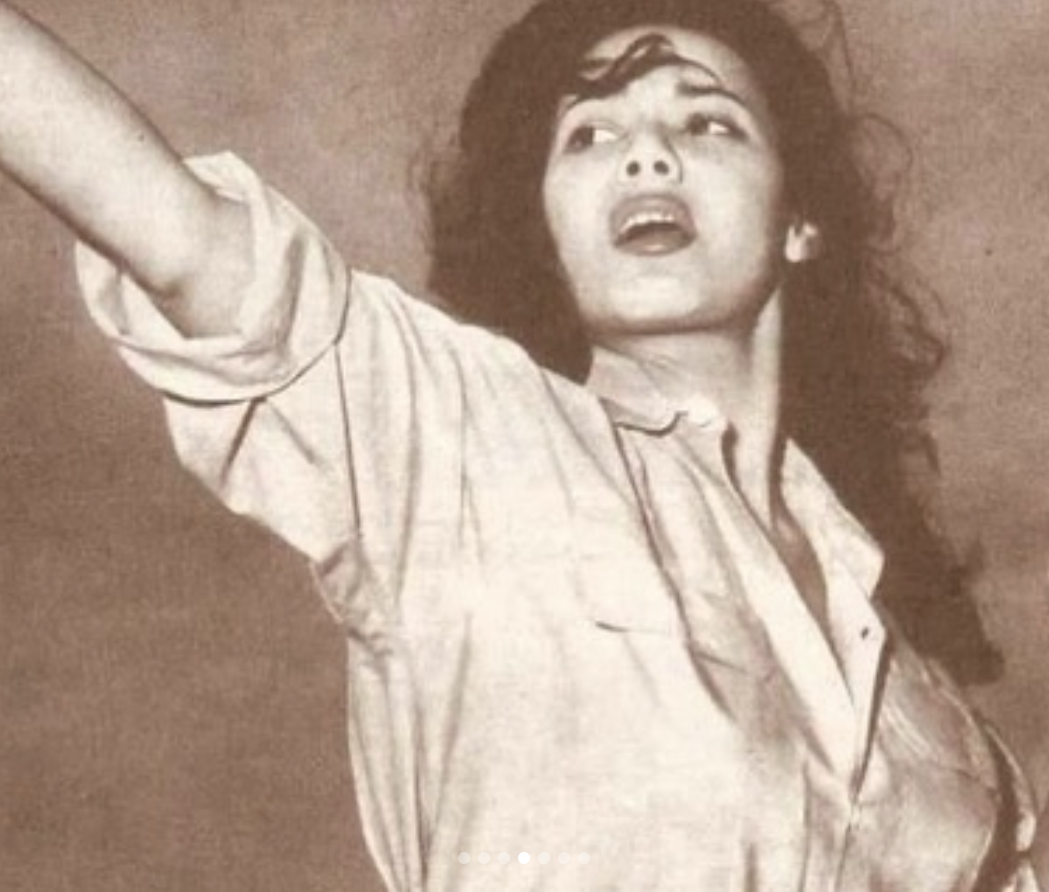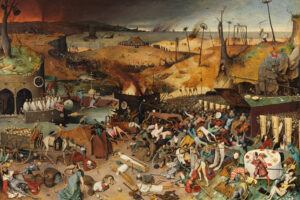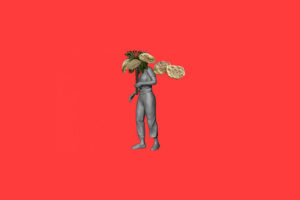
July 30, 2024
various stages of unheard
This text is published as part of Mizna 24.2: The Cinema Issue, guest-edited by Saeed Taji Farouky
On September 30, 2022, my research, archival, and curatorial platform, Maqam.tv1, was invited to host an evening at Tashweesh Festival, held in the Brussels-based arts center Beursschouwburg. I chose to screen Algerian novelist and filmmaker Assia Djebar’s La Nouba des femmes du Mont Chenoua2 (The Nouba of the Women of Mount Chenoua, 1977) and to give a lecture-performance as an introduction to the film. My current research revolves around ways of investigating, producing, disseminating and receiving knowledge, techniques and gestures, and the lecture-performance is a part of this work.
The set-up is as follows: The stage is that of a film theater and I am sitting at a desk in front of a computer, facing the audience. The computer’s screen is split into two halves: the left half contains the text I am reading to an audience; and the right contains the desktop version of Instagram, from which I’ll be soon playing short clips. The screen behind me (the same screen onto which the film will be later projected) shows the entirety of my computer screen.
Below is a modified version of the lecture-performance.
—Sophia Attigui
Assia Djebar has been continuously engaged in redressing the representation of the experiences of women during and after the war for liberation through her writings and her films. She has bound herself to listening and has been careful not to speak for her subjects. Even the very act of stealing the camera is part of this redressing.
—Sophia Attigui
Editorial note: the video lecture performance has been organized into Instagram carousel posts via Maqam.tv. The screenshots below link directly to specific video and image clips within the carousel posts that are being discussed in each section.
various stages of unheard
Part I. Obsessing
i.
From 1915 to 1920, French psychiatrist Gaëtan Gatian de Clérambault studied and compulsively photographed Tunisian and Moroccan women wearing haik, a garment common to both women and men at the time.
He became obsessed—took eight-hundred-plus photographs, kept countless notebooks with sketches and notes, and returned to France where he presented the result of his research on what he called “living draperies,” first to a conference held at the Sorbonne and then at the 1922 Colonial Exhibition held in Marseille, which earned him a gold medal. He then was solicited to teach courses on the subject of Arab draperies at the Académie des Beaux Arts in Paris, where his lectures were met with great success. He was later dismissed due to his alleged fetishist inclination for drapery.


ii.
Years later, between 1960 and 1962, Marc Garanger, an unofficial regimental photographer, was ordered to force Algerian women from Bordj Okhriss to take off their veils in order to be photographed. This was part of a broader visual and geographic control of the population. The women of Bordj Okhriss faced not only a lens but also a line of armed soldiers. They were not given a choice but they gave the camera defiant looks—their whole bodies in protest.

iii.
Between 1919 and 1929, the Soviet Union, under authority of Stalin, enacted large “civilizing” operations on the indigenous populations of Tajiks, Tatars, and Uzbeks. This series of actions was referred to as ھجوم (storming, assault) and was inscribed in the Soviet Union’s greater project of (a) according to some, erasure of nonaligned identities and (b) according to others, erasure of manifestations of gender inequality. The most notable event to take place during these years was the parade on March 8, 1927, when women, encircled by soldiers, removed their veils and burned them.



The French, while not exactly inexperienced in this political maneuvering, closely studied the Soviet operations. Eugene Daumas, who was at the head of the Arab Bureaus in the 1830s, had already grown an obsession for Algerian women and insisted on the necessity of unveiling them as part of a “civilizing mission.” By the end of May 1958, many regions of Algeria had seen burning and unveiling ceremonies that were highly theatrical and later proven to be staged.

iv.
In 1952, Franz Fanon was partaking in efforts for counter-representation. In a chapter of A Dying Colonialism (1959) titled, “Algeria Unveiled,” he spoke of the veil as a battleground for colonial and anticolonial strategies. He argued the following:
- (a) The veil gives women the power to look at the colonizer without being looked at. The latter is put in a position of nonreciprocity, which frustrates him. He insists on uncovering the women as a means of destructuring and “penetrating” the Algerian society. The Algerian man is compelled to defend the veil in a reactionary fashion.
- (b) The veil defines patterns of the visibility and corporeality of women in public space. As such, veiled women engage in schemes and dichotomies of in/out, veiled/unveiled, visible/invisible, carrier/noncarrier. The veil becomes instrument, medium, and after having been set aside for long, the bodies of Algerian women become stages for resistance and for fighting.

Although Fanon portrayed women as having an equal posture to men in the struggle for liberation, as the National Liberation Front claimed that liberation from colonialism would automatically create the conditions for the emancipation of women, decades later, Algerian women would not be liberated after independence.




v.
Iran, 1936. In efforts toward modern nation-building and westernization, Reza Shah launched a campaign called کشف الحجاب, unveiling, which consisted of forbidding Iranian women from wearing veils and chadors and forcing the adoption of European-style garments. Those who opposed the decision were violently repressed.


In 1943, Ayatollah Ruhollah Khomeini published a book called کشف الأسرار (Unveiling of the Secrets), in which he condemned the ban on veils and, more generally, the Shah’s allegedly antireligious governance.
In 1979, a few months after the Iranian Revolution, Khomeini announced that women were required to adopt the veil. A day later, on International Women’s Day, women took the streets to protest the decision. The protests, which lasted six days, were met with violent interventions and a later-dismissed government statement that veiling was only a recommendation. In 1983, the veil officially became mandatory for all women. Again, as during the Shah’s reign, those who opposed the decision were and are still violently repressed.


Part II. Obsessing, another take
1959. Fairuz has dedicated a song to Algerian مجاهدة, fighter, Djamila Bouhired, titled “رسالة إلى جميلة بوحيرد” (“Letter to Djamila Bouhired”). This is a year after director Youssef Chahine dedicated a film to her life. He called it “جميلة”, Djamila.

A year before that, Djamila Bouhired was tried, convicted, and sentenced to death by guillotine by the French after having been tortured for several days. They called her a terrorist. Badr Shakir al-Sayyab, Ahmed Abdel Muti Hijazi, Nazik al-Malaika, Nizar Qabbani, Rashid Hussein, Hassan Abdullah Qureshi, and Mohammed El Fitory, among hundreds of others, wrote poems about her. Nizar Qabbani finishes his poem by writing, “ما أصغر جون دارك فرنسا بجانب جون دارك في بلادي” (“How small is the French Joan of Arc in comparison with my country’s Joan of Arc”). Warda Al-Jazairia sang “كلنا جميلة” (“We are all Djamila”).


Djamila Bouhired is extremely popular, and she has been progressively elevated to the status of icon. Most often, and especially in Iraq, Egypt, and Syria, she is used as a pretext for the elevation of nationalist and socialist ideas.
Today, two mistakes keep recurring when referring to her:
- (a) A shot from Youssef Chahine’s movie showing the actress in a glorious and much flattering position is continuously mistaken for the real Djamila.
- (b) She is sometimes thought to have died a martyr. She is still very much alive now.

In 1971, Bouhired was interviewed by Walid Awad for the magazine الحوادث (The Events). Reacting to Awad’s repetitive glorifications of her story, she replied, “They all moved, like me, from the Casbah to the French quarter. Carrying bombs in their handbags and throwing them into cafés. I’m not really sure why all the publicity ended up centering on me. For there were many women in the prison with me, subjected to the worst kinds of torture, and they didn’t betray their comrades either. Each of them deserves pages and pages from the poets. All of us, all of us Djamilas were parts of the whole. Individuals don’t make a cause.” Awad is tone-deaf to her revision. She adds, “I simply played a small part in one period of the Algerian struggle.”
The history of Algerian women fighting for the liberation of their country has been carried, most times almost accidentally, by Djamila Bouhired and a few others such as Zohra Drif and Djamila Boupacha. The latter actually had her portrait painted by Picasso and was the subject of an eponymous solo for soprano composed by Luigi Nono in his 1962 composition, Canti di Vita e d’Amore.


Oddly enough, despite their positions as icons, these مجاهدات, fighters, are poorly represented on Algerian screens. They do not speak.

At the time, such bursts of iconization fell quite dissonantly upon some ears, in light of the quasi-absent portrayal of the other thousands of women who were involved in the struggle for independence in equally important but less spectacular ways. These never were voiceless, but they have been muted.
Assia Djebar has been continuously engaged in redressing the representation of the experiences of women during and after the war for liberation through her writings and her films. She has bound herself to listening and has been careful not to speak for her subjects. Even the very act of stealing the camera is part of this redressing. In her 1995 novel, Vaste est la Prison (So Vast the Prison), she writes about her filmmaking: “This artificial gaze that they have left you, smaller, a hundred, a thousand times more restricted that the one given you by Allah at birth, this strange slit that the tourists photograph because they think it is picturesque to have a little black triangle where the eye should be, this miniature gaze will henceforth be my camera. All of us from the world of the shadow women, reversing the process: we are finally the ones who are looking, who are beginning.”
Index of Instagram media references (@maqam.tv):
1, 2 Le Cri de la Soie (The Cry of the Silk, 1996) by Yvon Marciano, a dramatized account of Clérambault’s life.
3 Images of the World and the Inscription of War by Harun Farocki (1989).
4 Women burning their veils in Andijan, Uzbekistan, on International Women’s Day in 1927.
5 Episode 17 of the TV series, Ognennye dorogi, (Fiery Roads), produced by the USSR (1977—19845).
6 Soviet propaganda document (silent)—Her Right (Fracture) featuring a formerly veiled woman that escaped the conservatism of her family (1931).
7 French propaganda document—“Algérie, dix millions de français” (1958).
1 Femmes d’Alger (Women of Algiers) by Kamel Dehane (1992).
2, 3 Elles (Them) by Ahmed Lallem (1966).
4, 5 Fadéla M’Rabet interviewed on French television (1968).
6, Military commanders of the Iranian armed forces, government officials and their wives commemorating the abolition of the veil (1936).
7 Unveiling ceremony in Iran in the 30s (might be staged); source and date unknown
8, 9 Mouvement de libération des femmes iraniennes année zéro (Iranian Women’s Liberation Movement, Year Zero, 1979) by Iranian women and French MLF members.
1 “Letter to Djamila Bouhired” by Fairuz, written by the Rahbani brothers (1959) against images of Djamila by Youssef Chahine (1958), YouTube user edit.
2 “Djamila” read by an actor playing the poet in the biopic series Nizar Qabbani (2005).
3 “We are all Djamila” sung a capella by Warda Al-Jazairia on Qatari television (1974).
4 Film still from Djamila (1958) by Youssef Chahine.
5 Picasso portrait of Djamila Boupacha, Djamila Boupacha (1962) by Gisèle Halimi, prefaced by Simone de Beauvoir.
6 Barbara Hannigan performing “Djamila Boupacha” in 2013, from Luigi Nono’s Canti di Vita e d’Amore (1962).
7 La Bataille d’Alger (The Battle of Algiers, 1966) by Gillo Pontecorvo, based on the memoir of Yacef Saâdi.
Sophia Attigui is an artist, cultural practitioner, educator and graphic designer based in Casablanca, Morocco. She holds degrees in philosophy of art, fine arts and curatorial studies and regularly collaborates with organizations and artists on projects relating to film, discourse and the arts.
- 1. Maqam.tv (@maqam.tv on Instagram, www.maqamtv.com) is an itinerant broadcasting channel airing video content from mainly North to Central Africa and South to Central Asia. It is a research, archival, and curatorial platform that draws on a plethora of cultural knowledge and art practices to tell stories—; sometimes to tell them for the first time, sometimes to re-narrate them, sometimes to put them back into circulation. ↩︎
- 2. La Nouba des femmes du Mont Chenoua (1977) is an essay film in which Assia Djebar recounts songs, stories, and memories of Algerian women engaged in the resistance against colonial forces. The nouba is a traditional Andalusian musical form of five movements which inspired the disjointed structure of the film. Within each movement, Djebar uses a variety of regional music, blended with excerpts of Béla Bartók’s compositions inspired by time spent in Algeria. These fragments are tied together by Lila, who returns to her native town and travels around Mount Chenoua, where she drives from house to house to visit women who recall memories of war, grief, and suffering. Assia Djebar is one of the most important figures in francophone Maghrebian literature. She is the author of more than a dozen books, including Les Impatients (The Impatients, 1958), Ombre sultane (A Sister to Scheherazade, 1987), and Femmes d’Alger dans leur appartement (Women of Algiers in Their Apartment, 1980). Djebar directed two films during a decade-long hiatus from writing, the first one being La Nouba des femmes du Mont Chenoua, and the second, La Zerda ou les chants de l’oubli (The Zerda and the Songs of Forgetting, 1983). ↩︎

This text was published as a multidisciplinary extension of our special print journal Mizna: Cinema Issue, guest-edited by Saeed Taji Farouky. Inside the print journal, the essay is represented by a movie ticket designed by artist Lamia Abukhadra.












